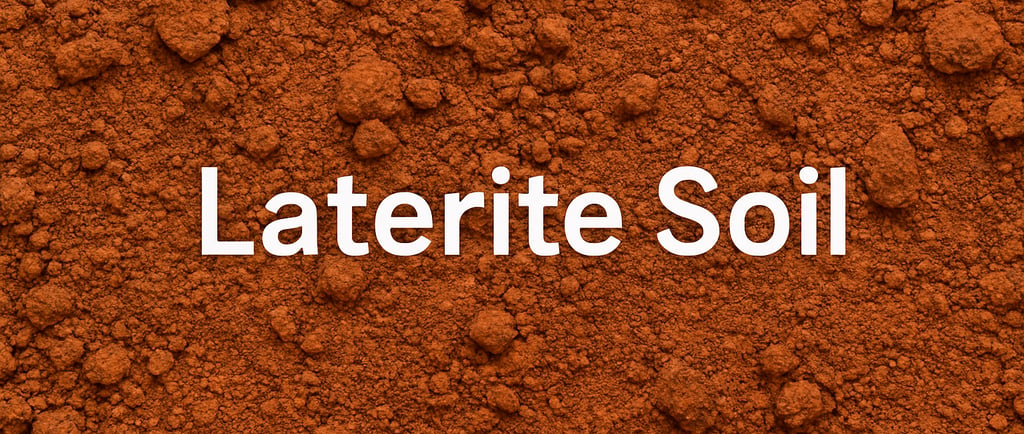Laterite Soil: Importance, Advantages, and Applications
Laterite soil is a type of soil that is derived from the weathering of parent rock material in tropical and subtropical climates. It is characterized by its rich mineral composition, which often includes iron and aluminum oxides.
SOIL HEALTH & FERTILITY
8/21/20258 min read


Introduction to Laterite Soil
Laterite soil is a type of soil that is derived from the weathering of parent rock material in tropical and subtropical climates. It is characterized by its rich mineral composition, which often includes iron and aluminum oxides. These minerals are the result of intense and prolonged weathering processes that occur in regions with high temperatures and frequent rainfall. As the parent rock material breaks down, laterite soil forms, taking on a distinct reddish-brown hue due to the concentration of iron oxide. This unique coloration is one of the key identifiers of laterite soil.
The texture of laterite soil can vary greatly, ranging from sandy to clayey, depending on the specific composition and the degree of weathering it has undergone. Generally, this type of soil possesses a porous structure, which allows for good drainage while also retaining essential nutrients. The formation process is heavily influenced by the climatic conditions, with laterite soils being more prevalent in areas where there is significant humidity. The water in these regions facilitates chemical weathering and leaching, leading to the accumulation of specific minerals.
Globally, laterite soil is found in various geographical locations, notably in the tropics of Africa, India, South America, and Southeast Asia. Countries such as Brazil, Nigeria, and Thailand have extensive laterite deposits that are crucial for agriculture and other land-use applications. The prevalence of this soil type in tropical regions not only highlights its geological significance but also its importance in supporting diverse ecosystems. This introduction lays the groundwork for understanding the vital roles laterite soil plays in agriculture, construction, and environmental conservation, inviting further exploration into its advantages and applications.
Importance of Laterite Soil in Agriculture
Laterite soil plays a crucial role in agricultural practices, particularly in tropical and subtropical regions. Its unique properties, including excellent drainage and high redox potential, make it conducive for a variety of crops. The formation of laterite soil occurs due to the weathering of parent rock material in humid environments, resulting in a rich mineral composition that can support agricultural growth.
One of the most significant characteristics of laterite soil is its ability to retain nutrients, which is essential for healthy plant growth. This soil type is generally rich in iron and aluminum, offering essential micronutrients necessary for various crops. However, while laterite soil provides nutrient retention capabilities, it can also pose challenges, such as acidity and leaching, that farmers must address. Adopting appropriate agricultural practices, such as soil amendments and proper crop rotation, can help mitigate these issues and optimize the soil’s productivity.
The drainage capacity of laterite soil is particularly advantageous for crops that require well-aerated roots, reducing the risk of root rot. This feature is beneficial for cultivating various food crops, including tubers and vegetables, which thrive in well-drained conditions. Farmers can utilize laterite soil for cultivating cash crops as well, benefiting from its relatively consistent moisture levels even in dry periods, enabling them to achieve reliability in crop yields.
However, crops grown in laterite soil may face other challenges. These include susceptibility to soil erosion during heavy rains, which can deplete the topsoil layer. Farmers are encouraged to employ conservation techniques, including contour farming and cover cropping, to protect the soil structure and maintain its fertility over time. By understanding the importance of laterite soil and employing suitable agricultural practices, farmers can successfully benefit from its properties, leading to sustainable agricultural development.
Advantages of Laterite Soil
Laterite soil is recognized for its distinctive characteristics and considerable advantages in agricultural practices and construction. One of the notable benefits of laterite soil is its high organic matter content, which is critical for supporting plant growth. This organic matter not only enhances soil structure but also improves its nutrient-holding capacity, making it particularly fertile. The biological activity within laterite soil contributes to the breakdown of organic materials, releasing essential nutrients that promote healthy crop development.
Additionally, laterite soil is renowned for its ability to retain moisture effectively. This characteristic is particularly advantageous in regions that experience intermittent rainfall, as it helps to maintain adequate moisture levels for crops during dry spells. The moisture-retention capability of laterite soil ensures that the roots of plants can access water, thus reducing the need for frequent irrigation. This water-holding property makes laterite an excellent option for sustainable agricultural practices, as it supports the cultivation of crops with minimal environmental impact.
Moreover, the low cost of maintenance associated with laterite soil makes it appealing for farmers and land developers. Due to its natural fertility and ability to sustain crops with less input, farmers can reduce expenditure on fertilizers and chemical amendments. This not only benefits the economic aspect of cultivating land but also minimizes the risks of soil degradation and environmental pollution. Furthermore, laterite soil can be used in various construction projects, including roads and buildings, due to its strength and durability. Its availability in many regions also contributes to its practical advantages, making it a viable choice for diverse applications.
In summary, the advantages of laterite soil encompass its rich organic matter content, moisture retention capacity, and cost-effectiveness. These qualities not only enhance soil fertility but also promote sustainable agricultural practices, making laterite soil a valuable resource in various agricultural and construction contexts.
Applications of Laterite Soil in Construction
Laterite soil is increasingly recognized for its significance in construction, particularly in tropical and sub-tropical regions where its availability is abundant. Due to its unique composition, laterite can be transformed into durable building materials such as bricks and tiles. These materials are not only sustainable but also economical, making them suitable alternatives to conventional construction materials.
In many parts of the world, especially in areas with high rainfall, laterite soil can be excavated and dried to form laterite bricks. These bricks exhibit considerable strength and can be used for various structural applications, including walls and pavements. Moreover, laterite bricks possess natural insulation properties, helping maintain comfortable indoor temperatures while reducing energy consumption in buildings. This aspect emphasizes the sustainability advantages of using laterite as a construction material.
Additionally, laterite is often used in tile production. The material can be processed into aesthetically pleasing tiles suitable for flooring and wall cladding. These tiles are particularly valued in tropical architecture, allowing for better heat dissipation and contributing to a structure’s overall energy efficiency.
However, it is essential to consider some drawbacks when utilizing laterite soil in construction. While it possesses several beneficial properties, laterite can be susceptible to weathering when exposed to extreme moisture and humidity without appropriate protective measures. This challenge necessitates using proper structural designs to mitigate potential deterioration and maintain structural integrity.
In comparison to conventional building materials such as concrete and fired bricks, laterite soil presents unique advantages, particularly in cost-effectiveness and environmental impact. The increased use of local resources minimizes transportation emissions, aligning with sustainable construction practices. As awareness of these benefits grows, the applications of laterite soil in construction are likely to expand, playing an essential role in the future of sustainable building in tropical regions.
Environmental Impact of Laterite Soil Use
Laterite soil, which is rich in iron and aluminum oxides, plays a significant role in various ecological processes. However, its extraction and utilization come with notable environmental implications. One of the primary concerns is soil erosion, which can be exacerbated by the removal of laterite from its natural environment. When laterite is mined, the protective vegetation cover is often stripped away, leading to increased susceptibility of the soil to erosion by wind and water. This erosion not only depletes the nutrient-rich topsoil but also results in sedimentation in nearby waterways, adversely affecting aquatic ecosystems.
Furthermore, the degradation of land associated with laterite mining can have long-term effects on the local environment. The alteration of landscapes can lead to a decline in biodiversity, as many plant and animal species depend on specific soil types and the habitats they create. The loss of laterite soil can result in a diminished capacity for the remaining land to support agricultural or natural ecosystems, ultimately leading to economic challenges for local communities that rely on these resources.
To mitigate these environmental impacts, it is crucial to adopt sustainable management practices for laterite soil. Strategies such as controlled mining practices, the re-vegetation of mined areas, and the implementation of agroforestry can significantly reduce ecological harm. Additionally, educating local stakeholders about the importance of laterite soil conservation can foster a sense of responsibility in managing these resources sustainably. Collaboration between policymakers, environmentalists, and local communities is essential to develop frameworks that balance economic needs with environmental integrity.
In conclusion, while laterite soil has various applications, its extraction and utilization must be managed carefully to minimize negative environmental impacts. Through sustainable practices and community engagement, it is possible to harness the benefits of laterite soil while preserving the ecological balance in the regions it occupies.
Case Studies: Successful Laterite Soil Utilization
Laterite soil has been effectively utilized in various regions around the globe, highlighting innovative agricultural practices and construction projects that leverage its unique properties. One noteworthy case is found in India, where laterite soil has been used extensively in the coastal regions of Kerala for building purposes. The state’s traditional architecture incorporates laterite bricks, which are known for their durability and aesthetic appeal. The use of locally sourced laterite not only reduces transportation costs but also supports sustainable practices by decreasing the carbon footprint associated with conventional construction materials.
Another fascinating example can be observed in Southeast Asia, specifically in Thailand. Farmers have adopted laterite soil for rice cultivation, relying on its high iron and aluminum content. This utilization improves soil fertility and promotes better drainage, which is crucial in rice farming. Innovative practices include integrating organic matter with laterite soil, enhancing nutrient retention and overall crop yield. This method has demonstrated how traditional farming techniques can be adapted to maximize the benefits of laterite soil.
In Brazil, laterite soils are a fundamental component of the Amazon rainforest's ecosystem. Researchers have explored the possibility of sustainable land management techniques that emphasize the use of laterite for agroforestry systems. This approach has shown remarkable results, as it allows for the cultivation of diverse crops alongside the preservation of the forest structure. By tapping into the natural properties of laterite soil, farmers can improve soil health while maintaining biodiversity.
These case studies illustrate the versatility of laterite soil in various contexts. From construction to agriculture, its unique characteristics have been successfully harnessed to meet diverse objectives. This successful utilization not only contributes to local economies but also aligns with broader sustainability goals, highlighting the potential of laterite soil in addressing environmental challenges.
Future Perspectives on Laterite Soil
The exploration of laterite soil is undergoing a transformational phase as researchers and practitioners recognize its significant potential in agricultural and engineering applications. Anticipated trends in research aim to deepen our understanding of the formation, composition, and variability of laterite soil across different geographical regions. Emphasizing the importance of regional studies will allow for nuanced applications of laterite soil management that consider local climatic and ecological contexts.
Technological advancements are set to play a vital role in enhancing the utilization of laterite soil. Innovations in soil testing and monitoring technologies, such as remote sensing and machine learning, will enable more accurate assessments of soil conditions. These technologies can facilitate the identification of optimal conditions for the sustainable use of laterite soil in construction and agriculture. For instance, artificial intelligence can assist in predicting how changes in land use or climate may affect the soil's properties, allowing stakeholders to adapt their strategies accordingly.
However, challenges persist as climate change continues to alter soil conditions globally. Increased rainfall and temperature fluctuations could impact the stability and fertility of laterite soil, prompting the need for adaptive management strategies. Stakeholders in agriculture, construction, and environmental conservation will need to be informed about these potential changes and the role that laterite soil can play in mitigating climate impacts, such as erosion and nutrient loss.
Education and awareness initiatives will be crucial for promoting the benefits of laterite soil utilization. Engaging local communities, policymakers, and researchers in discussions about sustainable practices can foster collaboration and align efforts towards responsible soil management. This comprehensive approach promises to maximize the advantages of laterite soil while addressing the emerging challenges posed by environmental changes. By actively pursuing knowledge and innovation, the future of laterite soil appears promising, with significant implications for various sectors.




"Boosting Crop Growth With Nature's Power"
Contact Us:
E Mail: support@frosil.com
Customer Care: +91 8329592991
FROSIL © 2025. All rights reserved.


'Frosil' is a fertilizer manufacturer committed to enhancing soil health and crop yields. We provide high-quality, eco-friendly products that support sustainable agriculture and help farmers achieve optimal results.
Registered Office: Gat No.96, Near Krushnai Hospital, Tandali. Tal- Shirur, Dist- Pune.
